
Figure 1. Pigeon Street by Aphex Twin
In a 1994 interview, Richard D. James, AKA Aphex Twin asserted, "my ears never turn off and I'm always listening to sounds, and I'm always breaking tracks down."[1] Aphex Twin consistently uses the term "track" to refer to his compositions. The term "song," as generically applied to most pop compositions would be inappropriate since so much of Aphex Twin's work is text-free electronic music. But the term "track" is also suggestive of the central tool for creating music in the studio - the multi-track tape recorder - a now nearly-obsolete piece of hardware that nonetheless still provides the time-structuring model for today's software mixers and sequencers.
I will discuss Aphex Twin's use of the track metaphor in composition, as a mechanism for creating music with a strong contrapuntal aspect. Counterpoint in classical music is the theory and practice of combining musical parts in a manner that preserves independence of the parts while creating a harmonious whole. The pedagogy of counterpoint consists of a set of rules for constructing melodic parts that fulfill certain criteria for what constitutes a well-formed melody, and what sort of simulaneities (or chords) are acceptable results of combining these melodies.
Counterpoint can be distinguished from melody and accompaniment, which predominates in pop music, in that contrapuntal textures lack the clear division between a single important part and one or more supporting parts. This gives the listener more choice about which parts to focus on, and of course more choice means greater demands on the listener's attention, perhaps one reason why counterpoint developed its abstruse reputation in classical music.
In the music discussed here, Aphex Twin creates most of his contrapuntal effects by combining looped materials in various configurations. Due to the intricate relations between different looped parts, the possibilities of recombination are sufficient to sustain an entire piece, without relying on formal structures commonly found in either classical or pop music. Some of the contrapuntal effects produced are strikingly similar to those found in early classical music, while others are more idiomatic to electronic music.

Figure 1. Pigeon
Street by Aphex Twin
The track Pigeon Street [2] (see Figure 1) is clearly comic in intent. We hear this in the surprising brevity of the composition (23 seconds), the droll conventional harmonic structure (I-IV-V), the cheesy timbres, and the somewhat awkward melody, the first half of which may be heard as a parody of octave-obsessed techno basslines. The two bar looped melody fades in on its second bar. Next we hear the complete melody. Then, surprisingly, we hear the melody with two notes cut out. At this point we realize that what we thought was a single melody is in fact a composite created by combining two independent melodic tracks. Since both tracks carry the same timbre, it is only the temporary omission of one track that reveals the melodic division of labor. The strange unbalanced quality of the occluded melody with a hole punched in its center, calls attention to the process of tracking. I define the term "tracking" as the technique of manipulating a contrapuntal texture through turning individual tracks on or off or otherwise manipulating them.

Figure 2. Pigeon Street, broken
into tracks
The contrapuntal technique of combining several parts to create a perceived composite has a European precedent called hocket. The technique was first developed in the 13th century, and by the early 14th century had become prevalent enough to win the censure of Pope John XXII who accused composers thus: melodias hoquetis intersecant. Translation: they cut apart melodies with hockets [3].
Before considering another Aphex Twin track that implements hockets with tracking, we will briefly look at two examples of hocket from the classical repertory. The first example is from Sederunt Principes by Perotin from the early 13th century. Here we have three melodic lines creating both texture and a composite melody, but no single part carries the composite melody exclusively.
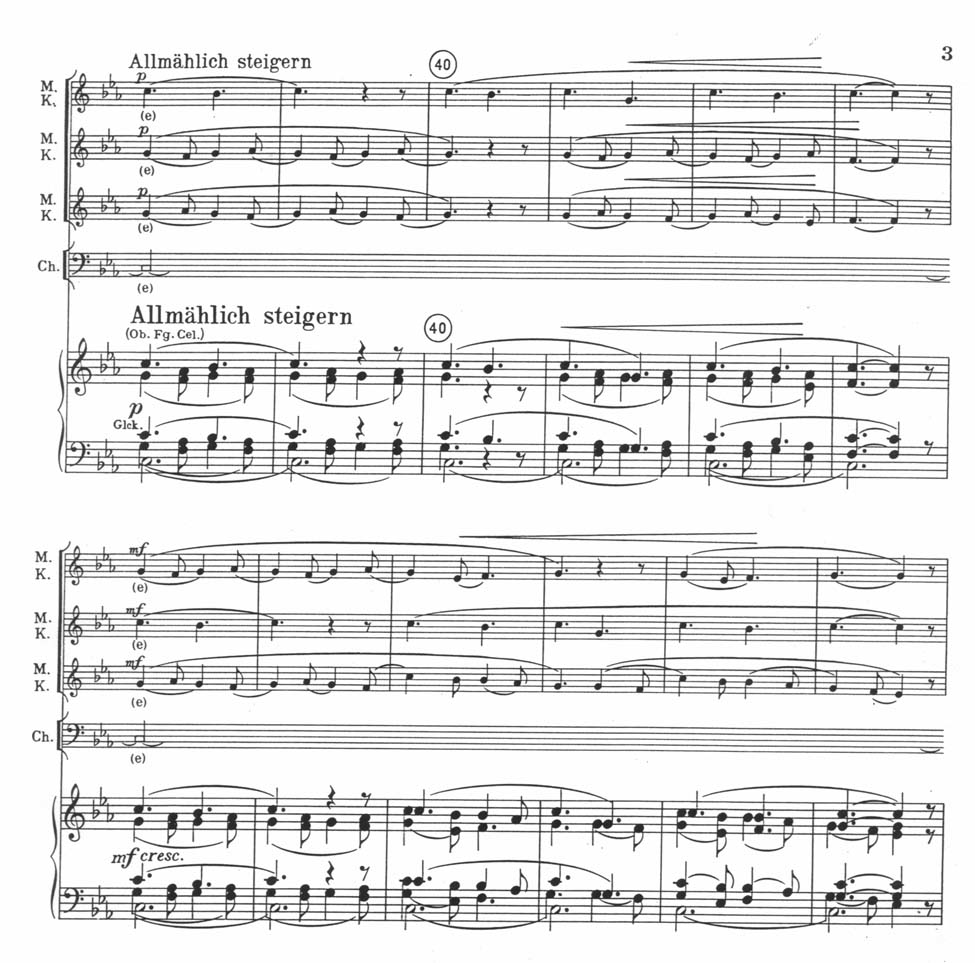
Figure 3.
Sederunt Principes by Perotin
The second hocket example is from J.S. Bach's St. Matthew Passion (1729). The hockets are passed back and forth between a double orchestra and chorus, and you can hear the composite result bouncing from side to side in the stereo field.
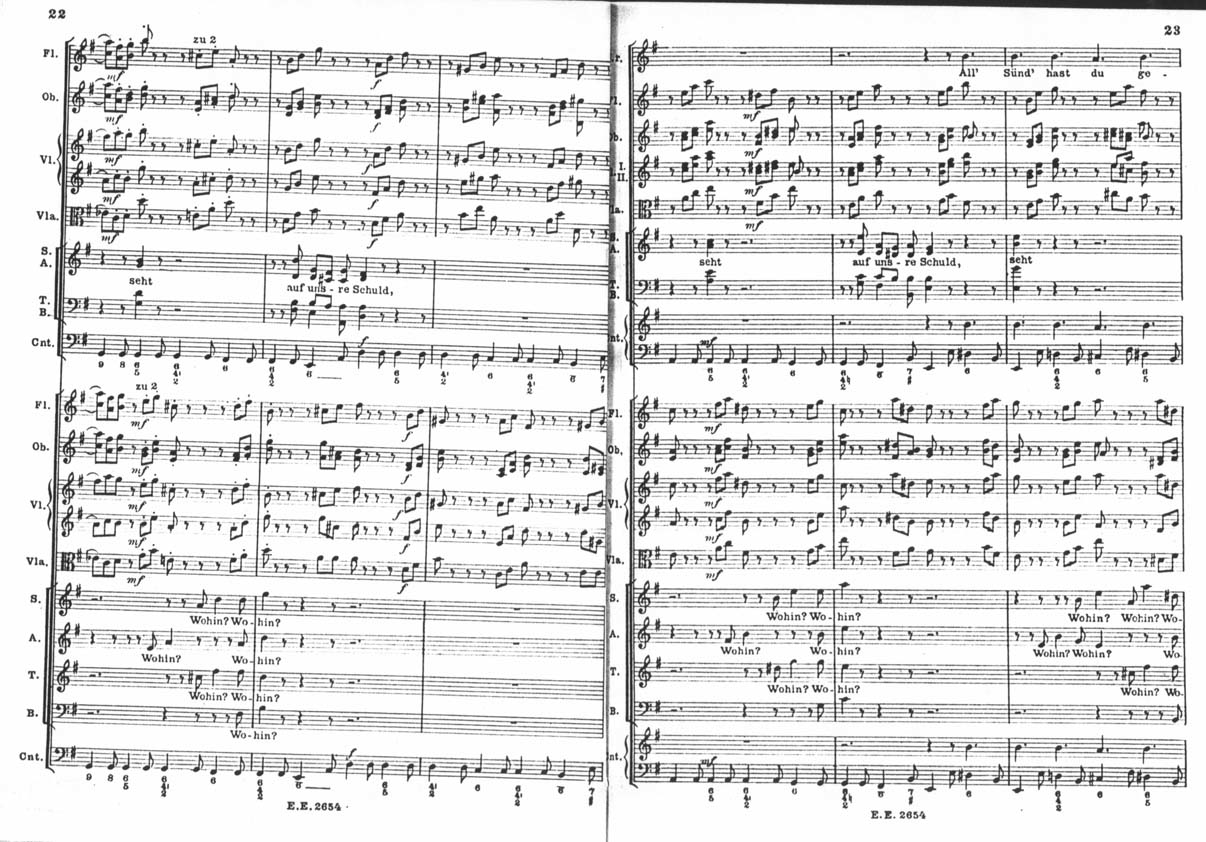
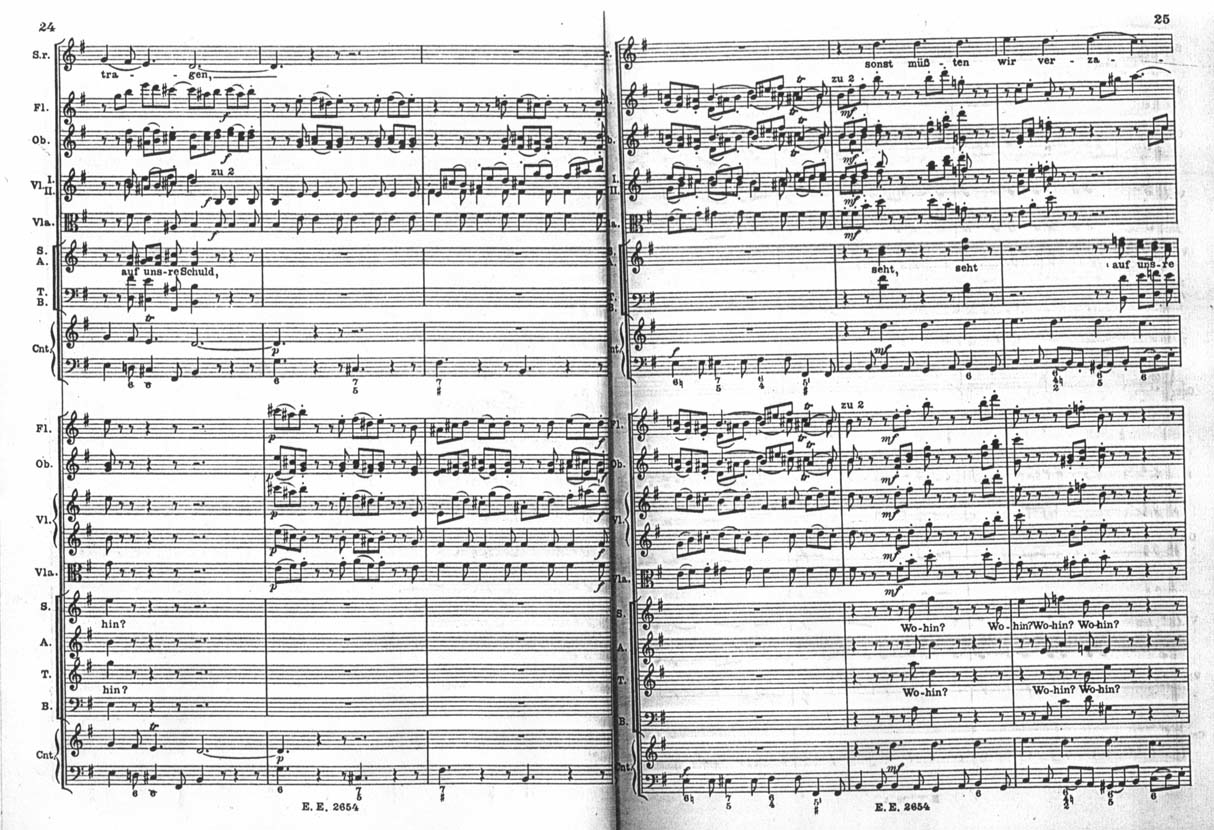
Figure 4. St.
Matthew Passion by J.S. Bach
An important difference here is that Aphex Twin's work is based on loops while Bach and Perotin employ melodies that change over time. Both Bach and Perotin were working on paper and conceiving music for voice where the musical lines are designed to support an evolving text. Aphex Twin began composing with tape loops and later adopted the same concept for the computer. There is no absolute technological determinism, but it is undeniable that different environments will suggest different musical approaches. And the variety and dynamism Aphex Twin derives from permuting the tracks is especially impressive considering the self-imposed limitation of working primarily with looped melodic materials, a severe constraint compared to the melodic practices of both Perotin and Bach.

Figure 5.
Xtal by Aphex Twin
(four-on-the-floor)
(breakbeat)
Now let's take a look at how the composite melody is actually built up (see Figure 6). We can see that there are several tracks contributing to the main melody, and many more tracks providing texture and other elements. (The score omits several other components for space considerations.) We will now listen to the opening of the track where the melody is gradually assembled. Then we will listen a bit later in the track where the melody is broken down to reveal more about the track division.
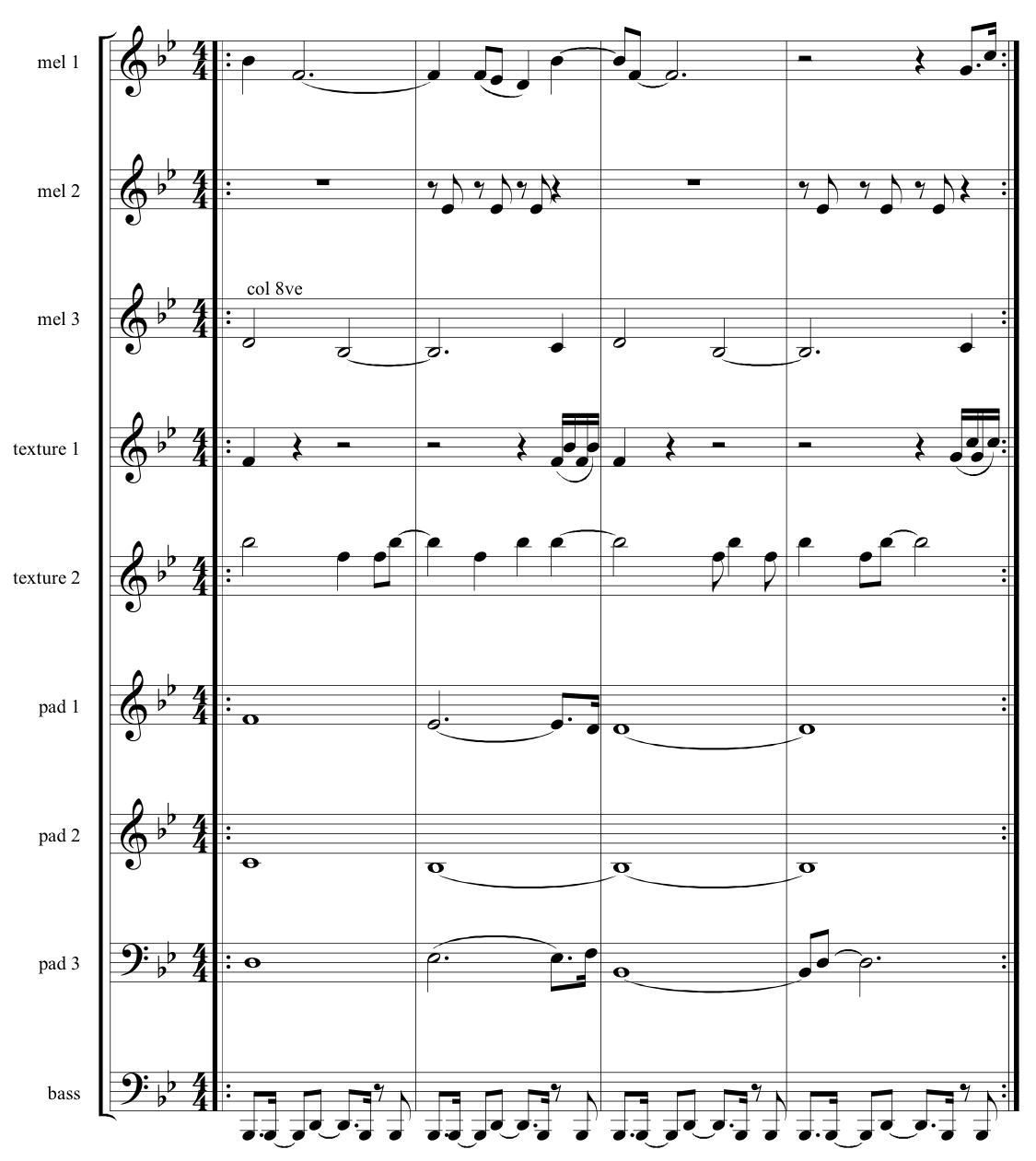
Figure 6.
Xtal with main elements broken down
(assembly)
(breakdown)
The composite has several attractive features. First, it is not purely monophonic but more ambiguously incorporates simultaneous lines, which create the monophonic melody we hear, and function as countermelody and texture reinforcement as well. Second, the composite is extended such that the underlying harmonic pad is substantial enough to merit treatment as an independent section. The duality between the two contrasting section materials mirrors the two types of beats: breakbeat and four-on-the-floor, which itself is mirrored in the two-note bassline. Finally, despite all this counterpoint going on, a smooth, diaphanous effect is created through the mixing techniques, such that the mechanics of the counterpoint are available if you wish to listen through them, but they are not intrusive if you wish to simply bliss out on the textures. And the mark of a successful musical technique is its ability work on listeners without their being consciously aware of its operation.
Thus far we have viewed tracks as individual musical parts,
superposed to create a final result. As we will see, in
Aphex Twin's music, the use of dynamic signal processing
also functions as a track in some cases. This is a central
feature in Aphex Twin's more recent music, where the rapid
succession of different forms of processing (such as in Come
to Daddy [5]) creates a klangfarbenmelodie effect. In
Xtal, we can hear an early example of this kind of
treatment, where processing is not just statically applied
to a track, but is dynamically manipulated, taking on a life
of its own. Listen carefully to the reverberant treatment of
the snare track in this section. The subtle changes and
overdubs create an enhancement of the snare drum that itself
constitutes another layer of complexity, another track.
(Xtal snare drum
reverberant processing focus)
Before we examine Xepha, we will hear a simpler example
of how downbeat reinterpretation works from She's a
Woman by the Beatles. [7]
(downbeat
reinterpretation in She's a Woman)
In She's a Woman it is completely natural to interpret the guitar chords at the outset as starting on the downbeat. However as soon as the drum and bass enter, it becomes clear that the guitar chords were actually on offbeats. Once you know the trick, you can make a conscious decisions at the outset to hear the guitar chords as on or off the beat, but it's more fun to hear them on the beat and then get confused when the rest of the instruments enter.
Returning to Xepha, we can see four different plausible phases of the rhythm loop. (See Figure 7. I'm omitting several rhythmic elements in this score.) Interestingly, The work starts with phase 1, the least stable interpretation, maximizing the likelihood that the listener will be surprised when other parts enter, and indicating that Aphex Twin is completely in control of the game being played. (In Phase 1, the lowest kick drum is situated on the second 16th of beat 1, a highly unstable configuration that is most like to resolve to Phase 3 in the listener's mind, pushing the perceived downbeat back by half a beat.) In the listening examples, we will first hear each plausible downbeat interpretation of the loop. Next we will hear a section where a reinterpretation is forced. Finally we will hear a bit of continuity to appreciate how the intricate combination of tracks allows the listener to float between interpretations.
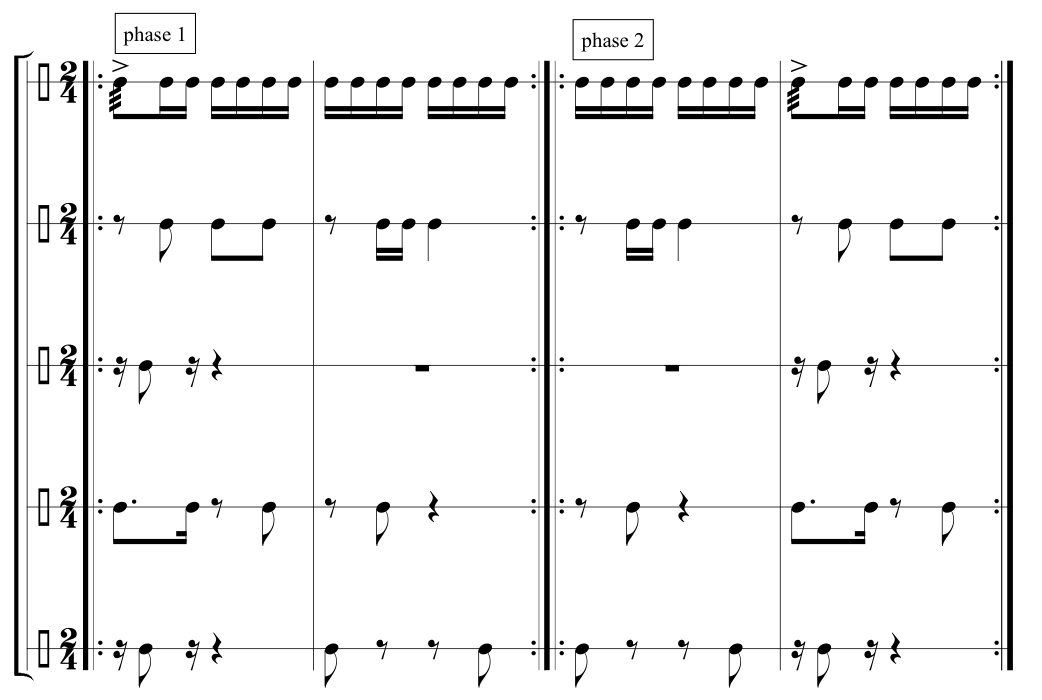
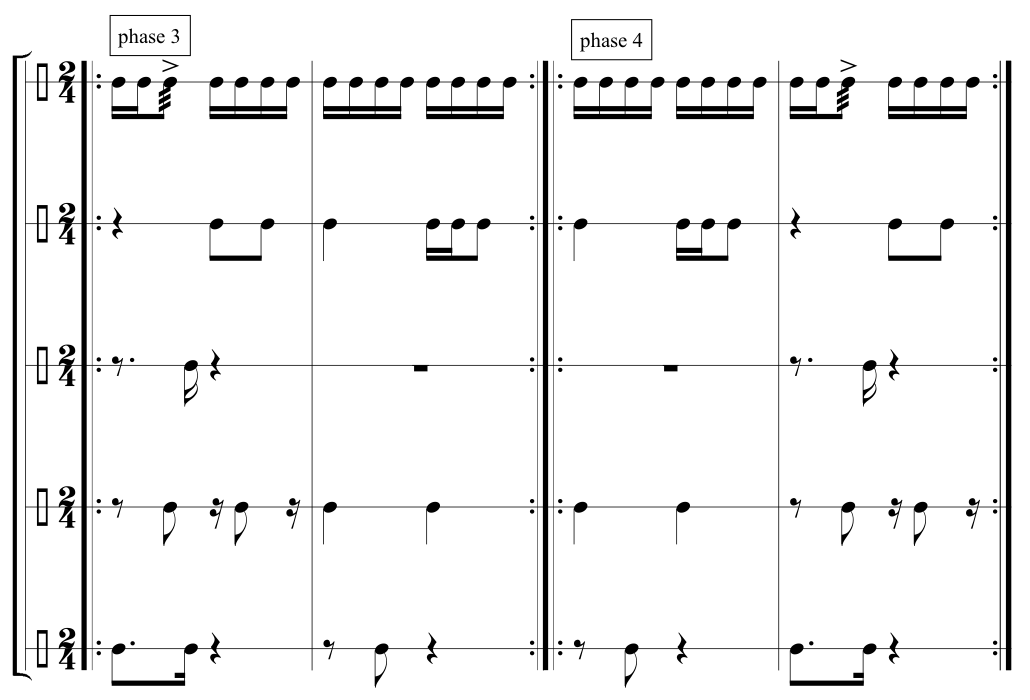
Figure 7.
Xepha rhythmic phases
(Xepha Phase 1)
(Xepha Phase 2)
(Xepha Phase 3)
(Xepha Phase 4)
(Xepha Forced downbeat reinterpretation)
(Xepha Unstable
continuity)
[1] Petros, G. Richie James. Seconds 1994; 25: 35-38.
[2] Caustic Window (1998). Pigeon Street. On
Compilation
[Audio CD]. London: Rephlex.
[3] Wolinski, Mary. The Medieval Hocket
http://the-orb.net/encyclop/culture/music/hocket.html
(accessed 10 July 2012).
[4] Aphex Twin (1992).
Selected Ambient Works I [Audio CD]. London: R&S Records.
[5] Aphex Twin (1997).
Come to Daddy [Audio CD].
London: Warp Records.
[6] Aphex Twin (1993). Xepha. On
On [Audio CD].
London: Warp Records.
[7] The Beatles (1964). She's A Woman. [Vinyl single].
London: Capitol Records.